Archives
All posts for the month February, 2019
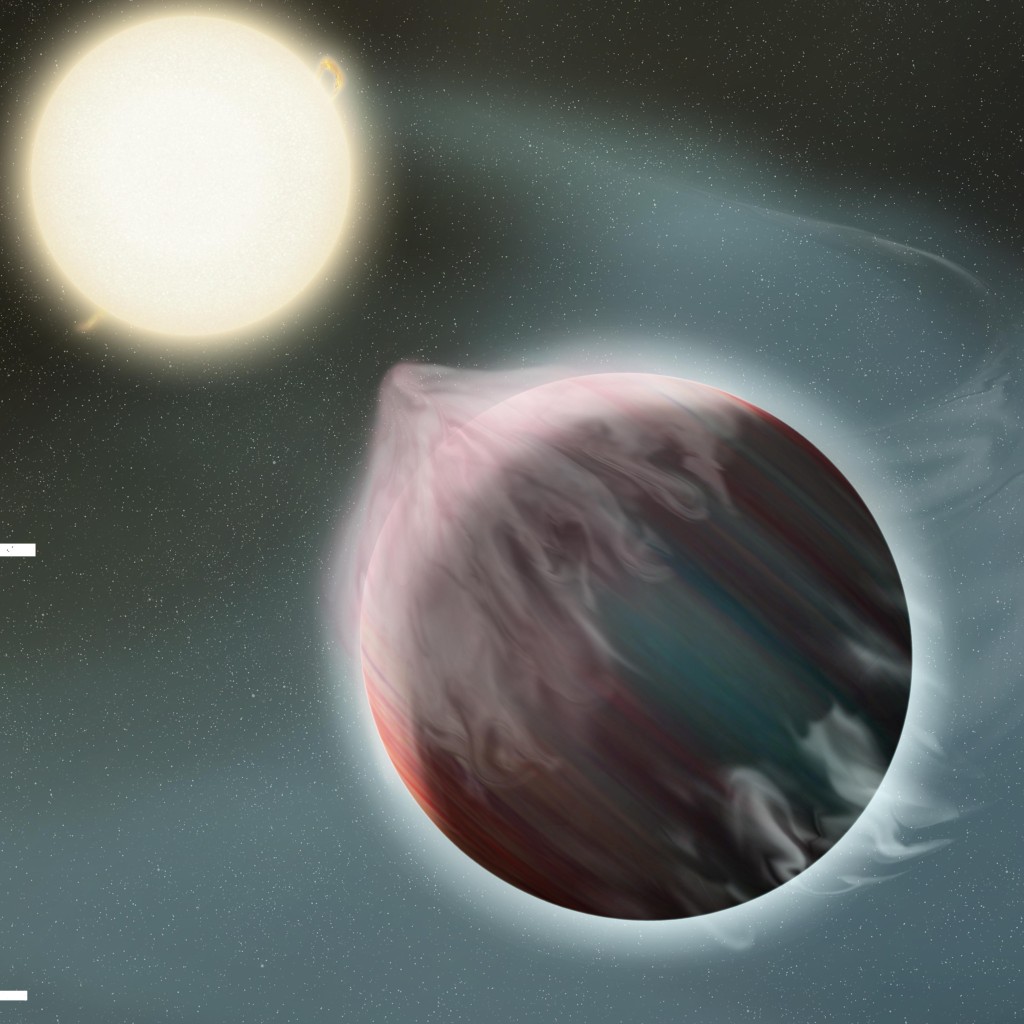
The very first exoplanet discovered around a Sun-like star, 51 Peg b, was a shocker – it’s a giant planet like Jupiter made mostly of hydrogen and helium but 100 times closer to its sun than Jupiter is to ours and whizzes around its orbit every 4 days.
Indeed, when its discoverers Michel Mayor and Didier Queloz first spotted the telltale spectral wobble of a planet in a 4-day orbit, they didn’t believe their discovery. At the time, everyone knew (or thought they knew) that planets like Jupiter could only form very far away from their host star.
Worse, so close to its star, 51 Peg b’s was being super-heated, and Mayor and Queloz worried that such a hot gas giant might quickly lose its hot, bloated atmosphere. And in their discovery paper, they suggested that the giant planet we see today as 51 Peg b might have started out as a brown dwarfthat shed trillions and trillions of lbs.
Later studies showed those early concerns about atmospheric blow-off were overblown and planets as massive as 51 Peg b, even if they are as scorched, probably can’t lose more than a fraction of their original mass. Since then, hot Jupiters like 51 Peg b, while cosmically rare, have become a fairly common type of exoplanet discovery.
But that doesn’t mean these planets aren’t losing a lot of mass, and a recent study from David Sing and colleagues looks at one of the mass-losing-est planets we know of, WASP-107b

From https://en.wikipedia.org/wiki/WASP-107b.
Sing and colleagues collected transit observations in infrared wavelengths of the WASP-107 system using the venerable Hubble Space Telescope. By looking in the infrared, they could search for the spectral signals of different gases in WASP-107b’s atmosphere.
WASP-107b is an especially good target for atmospheric characterization because its host star is very bright (compared to other planet hosts) and the planet itself is very low density – it has a mass a tenth that of Jupiter’s but a radius almost as big, giving the planet a density comparable to wind-packed snow.
With such a low density, WASP-107b’s atmosphere is puffy and distended, which means that its atmospheric gases can easily imprint their spectral signatures on the light observed by Hubble, making them easy to detect.
And for the first time in any exoplanet, Sing and colleagues saw signs of helium gas in WASP-107b’s atmospheric spectrum. In fact, the helium signal they saw was so whopping big that it suggests WASP-107b’s atmosphere is actively escaping, at a rate of about 10,000 tons per second.
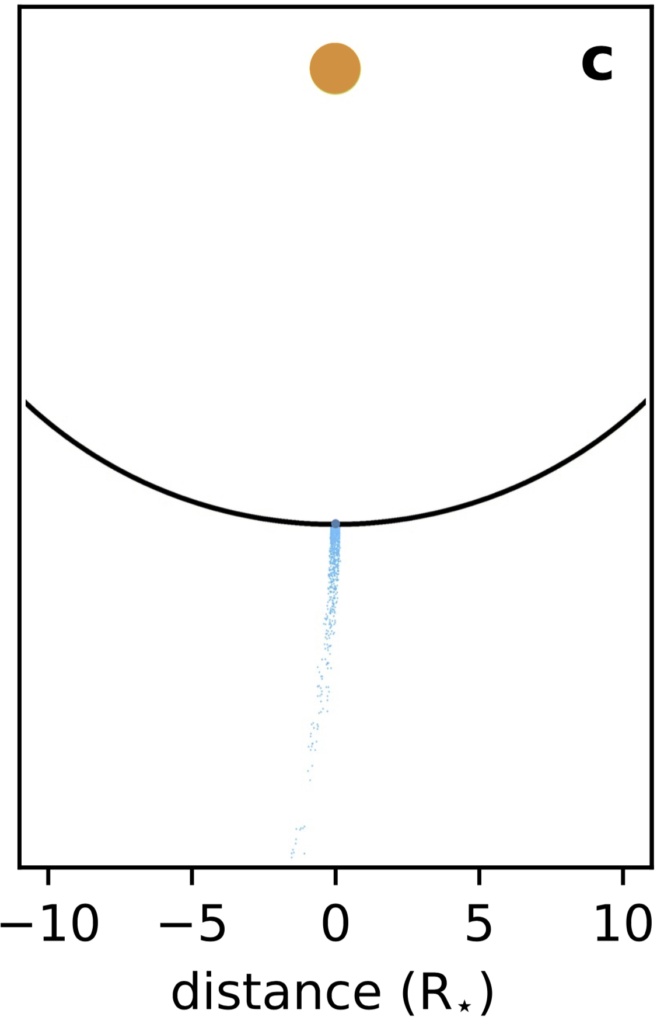
Even with such a high escape rate, WASP-107b won’t fall apart anytime soon – Sing and colleagues estimate it would only lose about 4% of its mass in a billion years.
But as we continue to find more exoplanets, we should probably expect to find more even closer to their host stars with even puffier atmospheres, perhaps some on the verge of being gravitationally ripped apart. So as with 51 Peg b’s discovery, exoplanets are likely to keep challenging our preconceived notions about where planets can and cannot be.

Arguably the best animé of all time, “Cowboy Bebop” is set in a not-too-distant future, when humans inhabit planets and moons across the solar system. In fact, one of the moon inhabited, Saturn’s moon Titan, features as the site of a violent, Desert Storm-like battle among sand dunes and scorpions.
“Cowboy Bebop” aired in Japan in 1998-1999, about a year after NASA launched the Cassini-Huygens mission to explore the Saturn system, including Titan. Shortly after arriving at Saturn, Cassini began collecting infrared observations of Titan, allowing scientists to peer through Titan’s hazy atmosphere. They found a surprisingly Earth-like world — violent but irregular storms (albeit of methane and ethane) and vast seas (primarily confined to the poles).
Scientists also found expansive dune fields girding the equator. Unlike terrestrial dunes, which are made mostly from silicate grains, these dunes were made (somehow) from carbon- and ice-rich particles. And an even more recent analysis of Cassini observations shows that Titan has something else in common with Earth: large dust storms.
In their study from late last year, Sébastien Rodriguez, an astronomer at the University Paris Diderot, and co-authors looked at maps of Titan collected by Cassini’s VIMS instrument and found that, over the dune regions, a large bright feature appeared and disappeared several times over the course of a few weeks.
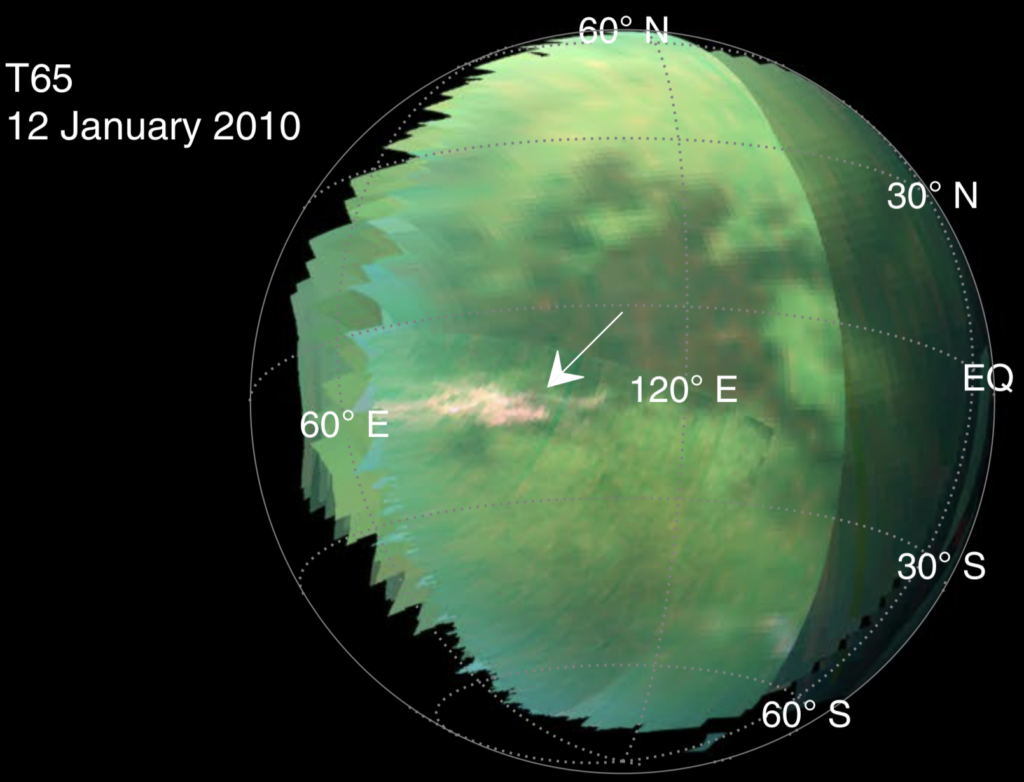
Now, just because there is a bright spot on Titan that changes with time does NOT mean it has to be a dust storm, but Rodriguez and colleagues go to great lengths to show that other explanations don’t fit.
For instance, previous observations of Titan found equatorial clouds that produced downpours of methane and ethane on the surface. Superficially, these clouds resembled Rodriguez’s putative dust storms.
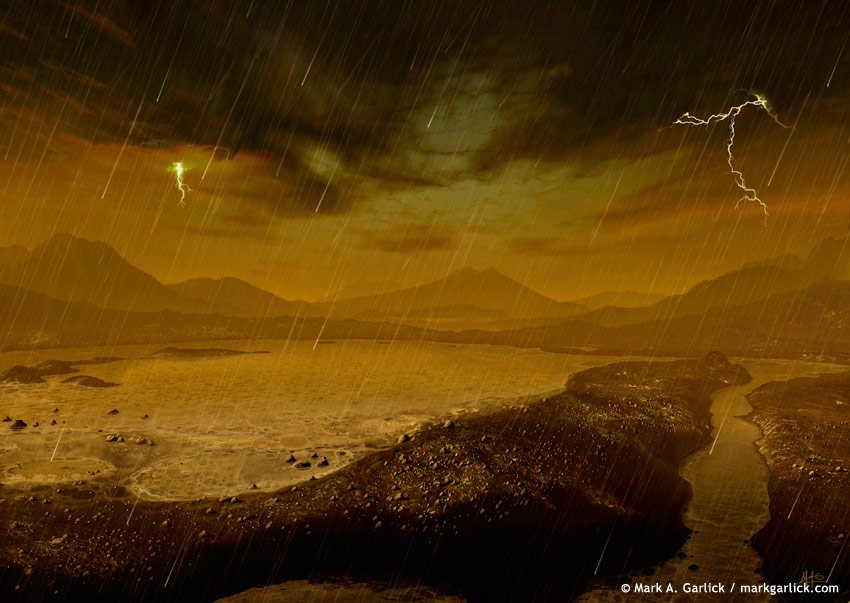
But Rodriguez’s dust clouds can only be seen in the few wavelengths of infrared light that are known to penetrate Titan’s atmosphere all the way to the ground. Storm clouds can be seen even in wavelengths that don’t reach the ground since they ascend high into the atmosphere.
Rodriguez and colleagues are even able to estimate the size of the dust grains — the dust clouds are much easier to see at 5 micron-wavelengths than at the shorter wavelengths that also probe to Titan’s surface. That probably means the grains are about 5 microns.
If Titan’s dust really is that small, it’s much smaller than sand grains and even smaller than the dust we usually see on Earth. It turns out that the aerodynamic behavior of a wind-blown particle depends, among other things, on its size. For a planet with a given atmospheric density, winds are good at blowing particles of a specific size — too small and the particles stick together; too big and the wind can’t lift the particles.
Rodriguez and colleagues estimate that windspeeds of about 3+ meters per second (about 7 miles per hour) would required to loft 5-micron dust grains on Titan. That may seem small, but the winds measured by the Huygens probe during its descent onto Titan measured even weaker near-surface winds of less than 2 meters per second.
However, the study’s authors point that stronger winds probably accompany Titanian rain storms. If such a storm had just taken place before they spotted the dust cloud, that could easily explain how the dust was lofted.
Ultimately, answering the question of Titan’s dust storms will require visiting the world again. Fortunately, NASA is investigating sending an automated drone to fly the Titanian skies, the Dragonfly mission, back to Titan in 2025. Whether that mission flies or not will be decided later this year.
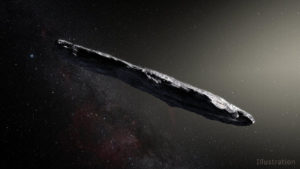
Artist’s conception of ‘Oumuamua.
The recent visit to our solar system by the interstellar object ‘Oumuamua has raised considerable controversy in the scientific community. Based on the fact that it is moving too fast to be trapped in an orbit around the Sun, ‘Oumuamua is the first object confidently identified as originating from outside our solar system. Its origin is unclear, and one likely possibility is that it is debris ejected from another planetary system. But Avi Loeb, chair of astronomy at Harvard, has proposed a more exciting but understandably controversial idea: ‘Oumuamua may be a probe from an alien civilization.
The idea’s not as crazy as it sounds — since interstellar distances take so long to cross (with current technologies, it’s at least 20 years to *our* nearest stellar neighbor), we think aliens are likely to explore using automated spacecraft rather than sending themselves.
And ‘Oumuamua did behave strangely during its short visit to our solar system. As it rounded the Sun, astronomers observed an anomalous acceleration inconsistent with the pull of the Sun’s gravity. For comets, such accelerations are common and attributed to jetting from vaporizing ice. But astronomers saw no evidence for such jetting from ‘Oumuamua. In addition, ‘Oumuamua has a funny shape, perhaps resembling a cigar, unusual but not totally impossible for a comet-like body.
Loeb has explained these anomalies by proposing that ‘Oumuamua is an alien solar sail, harnessing the radiation pressure from the Sun to navigate the cosmos. Such solar sails may be a low-cost, efficient means of plying the interstellar waters and have featured in recent technology demonstrations from the Planetary Society. If ‘Oumuamua were, indeed, a solar sail, that might explain both the anomalous acceleration and the unusual shape.
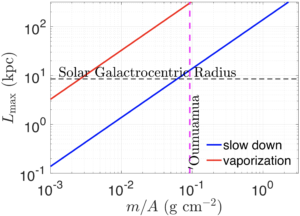
Fig. 1 from Bialy & Loeb (2019). The maximum distance a solar sail can travel L_max depends on the sail’s mass-to-area ratio, m/A, but Bialy and Loeb’s calculation suggest ‘Oumuamua could safely traverse the entire Milky Way.
One potential problem for is that, to work, a solar sail must be very light-weight and thin – the Planetary Society’s LightSail 2 spacecraft is a square almost six meters to a side, but weighing less than a bowling ball. It’s easy to imagine that such a cosmic tissue might not survive the rigors of interstellar travel. And so in a recent paper, Shmuel Bialy and Avi Loeb conduct a series of back-of-the-envelope calculations to argue that the interstellar rigors might not be so rigorous.
One of the biggest hazards for a solar sail would collisions with interstellar dust and gas – each collision could sap ‘Oumuamua’s momentum and vaporize its surface. However, Bialy and Loeb estimate that a solar-sail ‘Oumuamua could plausibly traverse tens or hundreds of kiloparsecs before such collisions would be a problem. That means ‘Oumuamua could cross the entire Milky Way before suffering a mission-ending number of collisions.
As compelling as their calculations are, my instinct (and that of most astronomers) is that ‘Oumuamua is something more mundane than an alien craft. But the conversation catalyzed by Loeb’s suggestions is probably healthy for the field of SETI, and certainly the public enthusiasm is encouraging – people love space and want desperately to find extraterrestrials.
The challenge is to keep these debates firmly scientific, to strike a balance between pushing the envelope and tearing the envelope to shreds. And the line between science and pseudo-science in the realm of alien life can be as tissue-thin as a solar sail.
